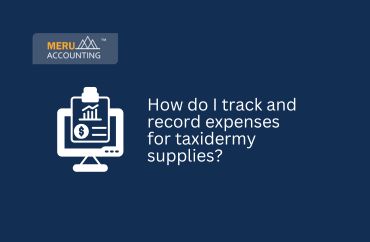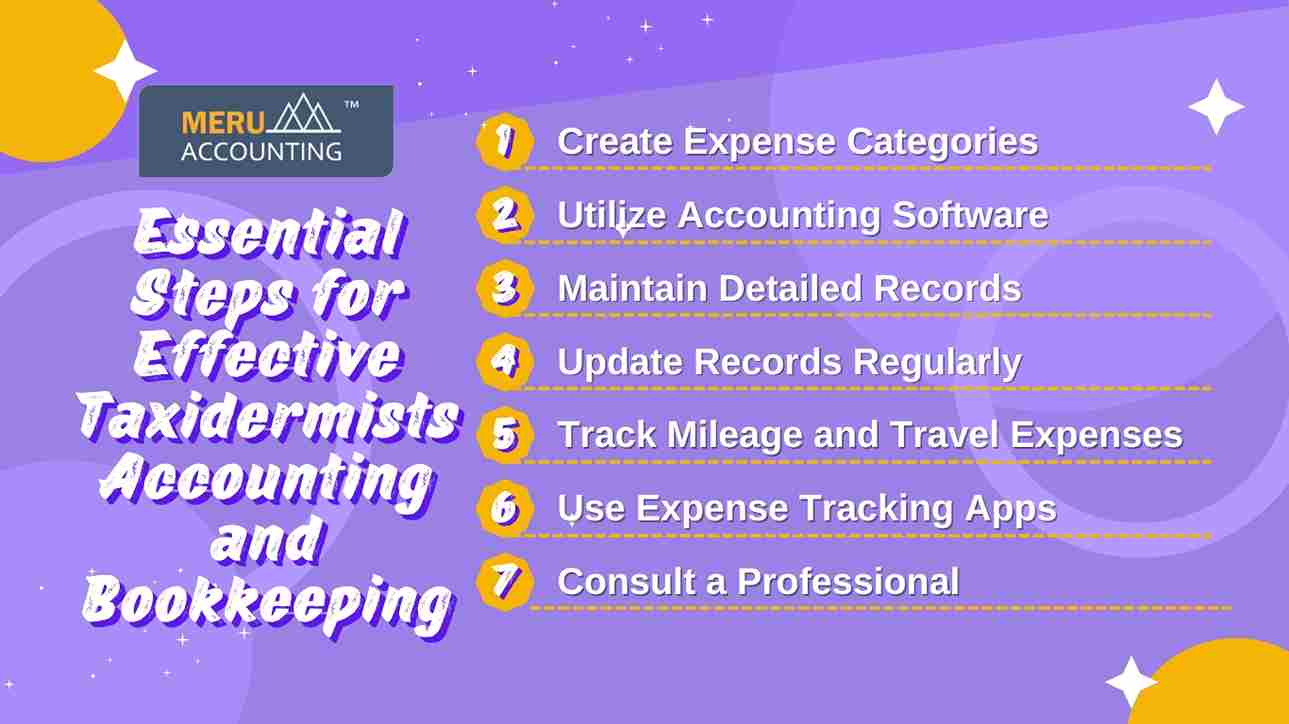
How do I track and record expenses for taxidermy supplies?

Hire A Dedicated Team
That Grows With You, Flexible, Scalable and
Always On Your Side
- Create Expense Categories: Organizing your expenses into specific categories is the foundation of effective Taxidermists bookkeeping. Categorize your expenses based on the type of supplies or costs incurred, such as chemicals, tools, materials, and other relevant items. Most accounting software allows you to create and customize these categories, which helps in easily tracking where your money is spent. When it’s time to review your finances or file taxes, having well-organized categories ensures that all expenses are accounted for and simplifies report generation.
- Utilize Accounting Software: Investing in accounting software like QuickBooks or Xero is essential for efficient Taxidermists accounting. These platforms enable you to track expenses, categorize them appropriately, and attach digital copies of receipts directly to your records. Additionally, they offer features like automated expense tracking, reconciliation with bank accounts, and the ability to generate detailed financial reports. This automation not only saves time but also reduces the risk of human error, making your financial management more accurate and reliable.
- Maintain Detailed Records: Keeping detailed records of all purchases is a critical part of Taxidermists bookkeeping. This includes retaining receipts, invoices, and any other documentation related to your expenses. Proper documentation is crucial for several reasons: it supports your claims during tax filing, provides evidence in case of an audit, and helps in monitoring and managing your cash flow. Ensure that each record is stored systematically, either in a physical file or digitally, to facilitate easy retrieval when needed.
- Update Records Regularly: Regular updates to your financial records are vital for accurate Taxidermists accounting. Schedule a specific time weekly or monthly to enter and review all expenses. This habit ensures that all transactions are recorded promptly, reducing the likelihood of missing or forgetting any expenses. Regular updates also make it easier to identify and correct any discrepancies in your records, keeping your books balanced and your financial picture clear.
- Track Mileage and Travel Expenses: If you travel to purchase supplies, attend taxidermy events, or meet clients, tracking these travel expenses is essential. Mileage and travel costs are often deductible, but they must be documented accurately as part of your Taxidermists bookkeeping. Use mileage tracking apps or maintain a logbook to record details such as the date, destination, purpose of the trip, and miles driven. Including these expenses in your financial records can help lower your taxable income and provide a more comprehensive view of your business costs.
- Use Expense Tracking Apps: Expense tracking apps like Expensify or Receipt Bank can significantly enhance your Taxidermists accounting process. These apps allow you to scan and store receipts, categorize expenses, and even integrate with your accounting software. By using such apps, you can ensure that all your expenses are captured and organized in real time, reducing the risk of lost receipts or unrecorded transactions. The integration with accounting software means that your records are always up-to-date and ready for review or reporting.
- Consult a Professional: While managing your finances independently is possible, consulting with an accountant who understands the taxidermy industry can offer significant benefits. A professional can provide tailored advice on specific deductions available to taxidermists, ensure compliance with ever-changing tax laws, and help optimize your Taxidermists bookkeeping practices. This expert guidance can save you time, reduce errors, and give you peace of mind, allowing you to focus more on your craft rather than on the complexities of financial management.
Conclusion
Keeping track of expenses for taxidermy supplies can be straightforward with the right approach. Establishing a dedicated system, maintaining detailed records, and consistently tracking your expenses are essential steps to staying organized. Utilizing apps and keeping a logbook can further simplify your taxidermists bookkeeping, making sure you’re well-prepared when tax season arrives. For an added layer of support, consulting with a professional can enhance your financial management and give you greater peace of mind. At Account Junction, we specialize in helping taxidermists with their bookkeeping needs, allowing you to concentrate on your craft with confidence.
Managing finances effectively is essential for any taxidermy business, and good expense tracking and record-keeping are key components. In taxidermists accounting, this means carefully documenting all costs related to taxidermy supplies, equipment, and other business expenses. Keeping accurate and organized financial records helps you see where your money is going, which is vital for managing your cash flow and ensuring your business remains profitable.
Simplifying your bookkeeping process doesn’t have to be complicated. Simple actions like regularly recording expenses, categorizing purchases, and keeping receipts can make taxidermists bookkeeping more manageable. Using accounting software can further simplify this process, allowing you to track income and expenses in real-time, generate reports, and keep your records up-to-date. By maintaining an organized system, you can significantly reduce the stress of tax season, avoid last-minute scrambles, and ensure that you’re fully prepared when it’s time to file taxes.
Essential Steps for Effective Taxidermists Accounting and Bookkeeping


Hire A Dedicated Team
That Grows With You, Flexible, Scalable and
Always On Your Side
- Create Expense Categories: Organizing your expenses into specific categories is the foundation of effective Taxidermists bookkeeping. Categorize your expenses based on the type of supplies or costs incurred, such as chemicals, tools, materials, and other relevant items. Most accounting software allows you to create and customize these categories, which helps in easily tracking where your money is spent. When it’s time to review your finances or file taxes, having well-organized categories ensures that all expenses are accounted for and simplifies report generation.
- Utilize Accounting Software: Investing in accounting software like QuickBooks or Xero is essential for efficient Taxidermists accounting. These platforms enable you to track expenses, categorize them appropriately, and attach digital copies of receipts directly to your records. Additionally, they offer features like automated expense tracking, reconciliation with bank accounts, and the ability to generate detailed financial reports. This automation not only saves time but also reduces the risk of human error, making your financial management more accurate and reliable.
- Maintain Detailed Records: Keeping detailed records of all purchases is a critical part of Taxidermists bookkeeping. This includes retaining receipts, invoices, and any other documentation related to your expenses. Proper documentation is crucial for several reasons: it supports your claims during tax filing, provides evidence in case of an audit, and helps in monitoring and managing your cash flow. Ensure that each record is stored systematically, either in a physical file or digitally, to facilitate easy retrieval when needed.
- Update Records Regularly: Regular updates to your financial records are vital for accurate Taxidermists accounting. Schedule a specific time weekly or monthly to enter and review all expenses. This habit ensures that all transactions are recorded promptly, reducing the likelihood of missing or forgetting any expenses. Regular updates also make it easier to identify and correct any discrepancies in your records, keeping your books balanced and your financial picture clear.
- Track Mileage and Travel Expenses: If you travel to purchase supplies, attend taxidermy events, or meet clients, tracking these travel expenses is essential. Mileage and travel costs are often deductible, but they must be documented accurately as part of your Taxidermists bookkeeping. Use mileage tracking apps or maintain a logbook to record details such as the date, destination, purpose of the trip, and miles driven. Including these expenses in your financial records can help lower your taxable income and provide a more comprehensive view of your business costs.
- Use Expense Tracking Apps: Expense tracking apps like Expensify or Receipt Bank can significantly enhance your Taxidermists accounting process. These apps allow you to scan and store receipts, categorize expenses, and even integrate with your accounting software. By using such apps, you can ensure that all your expenses are captured and organized in real time, reducing the risk of lost receipts or unrecorded transactions. The integration with accounting software means that your records are always up-to-date and ready for review or reporting.
- Consult a Professional: While managing your finances independently is possible, consulting with an accountant who understands the taxidermy industry can offer significant benefits. A professional can provide tailored advice on specific deductions available to taxidermists, ensure compliance with ever-changing tax laws, and help optimize your Taxidermists bookkeeping practices. This expert guidance can save you time, reduce errors, and give you peace of mind, allowing you to focus more on your craft rather than on the complexities of financial management.
Conclusion
Keeping track of expenses for taxidermy supplies can be straightforward with the right approach. Establishing a dedicated system, maintaining detailed records, and consistently tracking your expenses are essential steps to staying organized. Utilizing apps and keeping a logbook can further simplify your taxidermists bookkeeping, making sure you’re well-prepared when tax season arrives. For an added layer of support, consulting with a professional can enhance your financial management and give you greater peace of mind. At Account Junction, we specialize in helping taxidermists with their bookkeeping needs, allowing you to concentrate on your craft with confidence.
